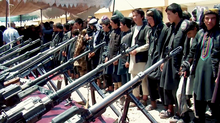
An armoured fighting vehicle or armored fighting vehicle (AFV) is an armed combat vehicle protected by armour, generally combining operational mobility with offensive and defensive capabilities. AFVs can be wheeled or tracked. Examples of AFVs are tanks, armoured cars, assault guns, self-propelled artilleries, infantry fighting vehicles (IFV), and armoured personnel carriers (APC).

Artillery is a class of heavy military ranged weapons that launch munitions far beyond the range and power of infantry firearms. Early artillery development focused on the ability to breach defensive walls and fortifications during sieges, and led to heavy, fairly immobile siege engines. As technology improved, lighter, more mobile field artillery cannons developed for battlefield use. This development continues today; modern self-propelled artillery vehicles are highly mobile weapons of great versatility generally providing the largest share of an army's total firepower.

Self-propelled artillery is artillery equipped with its own propulsion system to move toward its firing position. Within the terminology are the self-propelled gun, self-propelled howitzer, self-propelled mortar, and rocket artillery. They are high mobility vehicles, usually based on continuous tracks carrying either a large field gun, howitzer, mortar, or some form of rocket/missile launcher. They are usually used for long-range indirect bombardment support on the battlefield.

A tank is an armoured fighting vehicle intended as a primary offensive weapon in front-line ground combat. Tank designs are a balance of heavy firepower, strong armour, and good battlefield mobility provided by tracks and a powerful engine; usually their main armament is mounted in a turret. They are a mainstay of modern 20th and 21st century ground forces and a key part of combined arms combat.
The United States Armed Forces are the military forces of the United States. The armed forces consists of six service branches: the Army, Marine Corps, Navy, Air Force, Space Force, and Coast Guard. All six armed services are among the eight uniformed services of the United States.

A weapon, arm, or armament is any implement or device that is used to deter, threaten, inflict physical damage, harm, or kill. Weapons are used to increase the efficacy and efficiency of activities such as hunting, crime, law enforcement, self-defense, warfare, or suicide. In broader context, weapons may be construed to include anything used to gain a tactical, strategic, material, or mental advantage over an adversary or enemy target.

A military aircraft is any fixed-wing or rotary-wing aircraft that is operated by a legal or insurrectionary military of any type. Military aircraft can be either combat or non-combat:

Combined arms is an approach to warfare that seeks to integrate different combat arms of a military to achieve mutually complementary effects—for example, using infantry and armour in an urban environment in which each supports the other.
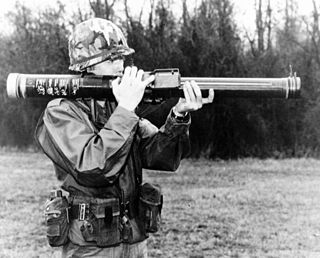
Anti-tank warfare originated from the need to develop technology and tactics to destroy tanks during World War I. Since the Allies deployed the first tanks in 1916, the German Empire developed the first anti-tank weapons. The first developed anti-tank weapon was a scaled-up bolt-action rifle, the Mauser 1918 T-Gewehr, that fired a 13.2 mm cartridge with a solid bullet that could penetrate the thin armor of tanks at that time and destroy the engine or ricochet inside, killing occupants. Because tanks represent an enemy's strong force projection on land, military strategists have incorporated anti-tank warfare into the doctrine of nearly every combat service since. The most predominant anti-tank weapons at the start of World War II in 1939 included the tank-mounted gun, anti-tank guns and anti-tank grenades used by the infantry, and ground-attack aircraft.

An airstrike, air strike, or air raid is an offensive operation carried out by aircraft. Air strikes are delivered from aircraft such as blimps, balloons, fighter aircraft, attack aircraft, bombers, attack helicopters, and drones. The official definition includes all sorts of targets, including enemy air targets, but in popular usage the term is usually narrowed to a tactical (small-scale) attack on a ground or naval objective as opposed to a larger, more general attack such as carpet bombing. Weapons used in an airstrike can range from direct-fire aircraft-mounted cannons and machine guns, rockets and air-to-surface missiles, to various types of aerial bombs, glide bombs, cruise missiles, ballistic missiles, and even directed-energy weapons such as laser weapons.
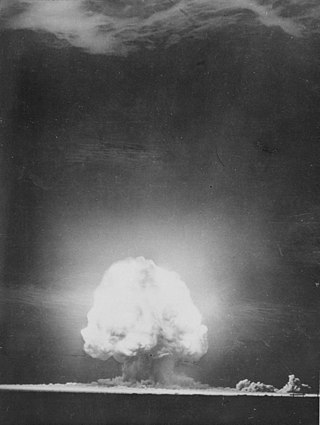
Technology played a significant role in World War II. Some of the technologies used during the war were developed during the interwar years of the 1920s and 1930s, much was developed in response to needs and lessons learned during the war, while others were beginning to be developed as the war ended. Many wars have had major effects on the technologies that we use in our daily lives, but World War II had the greatest effect on the technology and devices that are used today. Technology also played a greater role in the conduct of World War II than in any other war in history, and had a critical role in its outcome.
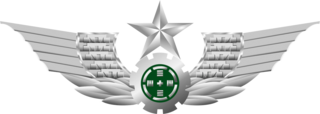
The People's Liberation Army Ground Force is the land-based service branch of the People's Liberation Army and the largest and oldest branch of the entire Chinese armed forces. The PLAGF can trace its lineage from 1927 as the Chinese Red Army; however, it was not officially established until 1948.
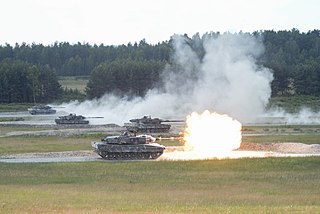
Armoured warfare or armored warfare, is the use of armoured fighting vehicles in modern warfare. It is a major component of modern methods of war. The premise of armoured warfare rests on the ability of troops to penetrate conventional defensive lines through use of manoeuvre by armoured units.

Insurgency weapons and tactics (IWAT) are weapons and tactics, most often involving firearms or explosive devices, intended for use by insurgents to engage in guerrilla warfare against an occupier, or for use by rebels against an established government. One type of insurgency weapon are "homemade" firearms made by non-professionals, such as the Błyskawica (Lightning) submachine gun produced in underground workshops by the Polish resistance movement. Another weapon that is part of the conventional military arsenal, but which has been taken up to great effect by insurgents, is the RPG. Two examples of an improvised weapon used by insurgents would be the improvised explosive devices used in Iraq and the Molotov cocktails used against vehicles and tanks. Two tactics used by many insurgents are assassinations and suicide bomb attacks. The latter tactic is used when an insurgent has a bomb strapped to them or in their car, which provides a low-tech way for insurgents to get explosives close to critical enemy targets.

Infantry tactics are the combination of military concepts and methods used by infantry to achieve tactical objectives during combat. The role of the infantry on the battlefield is, typically, to close with and engage the enemy, and hold territorial objectives; infantry tactics are the means by which this is achieved. Infantry commonly makes up the largest proportion of an army's fighting strength, and consequently often suffers the heaviest casualties. Throughout history, infantrymen have sought to minimise their losses in both attack and defence through effective tactics.

Industrial warfare is a period in the history of warfare ranging roughly from the early 19th century and the start of the Industrial Revolution to the beginning of the Atomic Age, which saw the rise of nation-states, capable of creating and equipping large armies, navies, and air forces, through the process of industrialization.
The following outline is provided as an overview of and topical guide to military science:

The artillery of World War I, which led to trench warfare, was an important factor in the war, influenced its tactics, operations, and incorporated strategies that were used by the belligerents to break the stalemate at the front. World War I raised artillery to a new level of importance on the battlefield.

A ground combat vehicle, also known as a land assault vehicle or simply a combat vehicle or an assault vehicle, is a land-based military vehicle intended to be used for combat operations. They differ from non-combat military vehicles such as trucks in that they are designed for use in active combat zones, to be used in mechanized warfare and mobile infantry roles.
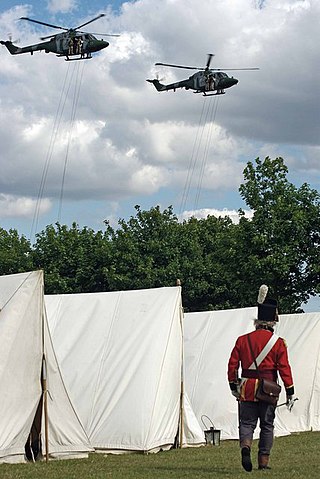
In military history, the term "generations of warfare" refers to the concept of five "generations" in warfare, with each generation having different tactics, strategies, and technologies. The generations of warfare are sometimes dubbed as "4GW" or "5GW". The term originated in 1989 to describe "the changing face of war" over time, initially only referring to the emergence of the fourth generation, but eventually seeing the addition of a fifth generation.



